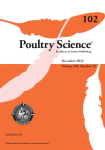Ver ítem
- xmlui.general.dspace_homeCentros e Institutos de InvestigaciónCICVyA. Centro de Investigación en Ciencias Veterinarias y AgronómicasInstituto de BiotecnologíaArtículos científicosxmlui.ArtifactBrowser.ItemViewer.trail
- Inicio
- Centros e Institutos de Investigación
- CICVyA. Centro de Investigación en Ciencias Veterinarias y Agronómicas
- Instituto de Biotecnología
- Artículos científicos
- Ver ítem
Study of coinfection with local strains of infectious bursal disease virus and infectious bronchitis virus in specific pathogen-free chickens
Resumen
Immunosuppressive diseases cause great losses in the poultry industry, increasing the susceptibility to infections by other pathogens and promoting a suboptimal response to vaccination. Among them, infectious bursal disease virus (IBDV) arises as one of the most important around the world. IBDV infects immature B lymphocytes, affecting the immune status of birds and facilitating infections by other pathogens such as avian infectious bronchitis virus
[ver mas...]
Immunosuppressive diseases cause great losses in the poultry industry, increasing the susceptibility to infections by other pathogens and promoting a suboptimal response to vaccination. Among them, infectious bursal disease virus (IBDV) arises as one of the most important around the world. IBDV infects immature B lymphocytes, affecting the immune status of birds and facilitating infections by other pathogens such as avian infectious bronchitis virus (IBV). Although it has been reported that the interaction between these viruses increases IBV clinical signs, there are no actual studies about the interaction between regional circulating isolates that validate this statement. In this context, the objective of our work was to evaluate the effect of the interaction between local isolates of IBDV (belonging to genogroup 4) and IBV (lineage GI-16) in chickens. Thus, specific pathogen-free chickens were orally inoculated with IBDV genogroup (G) 4 or with PBS at 5 d of age. At 14-days postinoculation (dpi) the animals were intratracheally inoculated with a GI-16 IBV or with PBS. At multiple time points, groups of birds were euthanized and different parameters such as histological damage, viral load, lymphocyte populations and specific antibodies were evaluated. The success of IBDV infection was confirmed by the severity of bursal atrophy, viral detection, and presence of anti-IBDV antibodies. In IBV-infected animals, the presence of viral genome was detected in both kidney and bursa. The coinfected animals showed higher degree of lymphocyte infiltration in kidney, higher rate of animals with IBV viral genome in bursa at 28 dpi, and a clear decrease in antibody response against IBV at 28, 35, and 40 dpi. The results indicate that the infection with the local isolate of IBDV affects the immune status of the chickens, causing major severe damage, in response to IBV infection, which could consequently severely affect the local poultry industry.
[Cerrar]

Fuente
Poultry Science 102 (12) : 103129 (Diciembre 2023)
Fecha
2023-12
Editorial
Elsevier
ISSN
1525-3171
Documentos Relacionados
Formato
pdf
Tipo de documento
artículo
Proyectos
(ver más)
INTA/2019-PD-E5-I105-001, Patógenos animales: su interacción con el hospedador y el medio ambiente. Impacto en productividad, ecosistemas, sanidad animal y salud pública en el marco ?Una Salud?
INTA/2019-PD-E5-I102-001, Desarrollo de vacunas y tecnologías para mejorar las estrategias profilácticas y terapéuticas de las enfermedades que afectan la producción animal y la salud pública
Palabras Claves
Derechos de acceso
Abierto
 Excepto donde se diga explicitamente, este item se publica bajo la siguiente descripción: Creative Commons Attribution-NonCommercial-ShareAlike 2.5 Unported (CC BY-NC-SA 2.5)
Excepto donde se diga explicitamente, este item se publica bajo la siguiente descripción: Creative Commons Attribution-NonCommercial-ShareAlike 2.5 Unported (CC BY-NC-SA 2.5)


